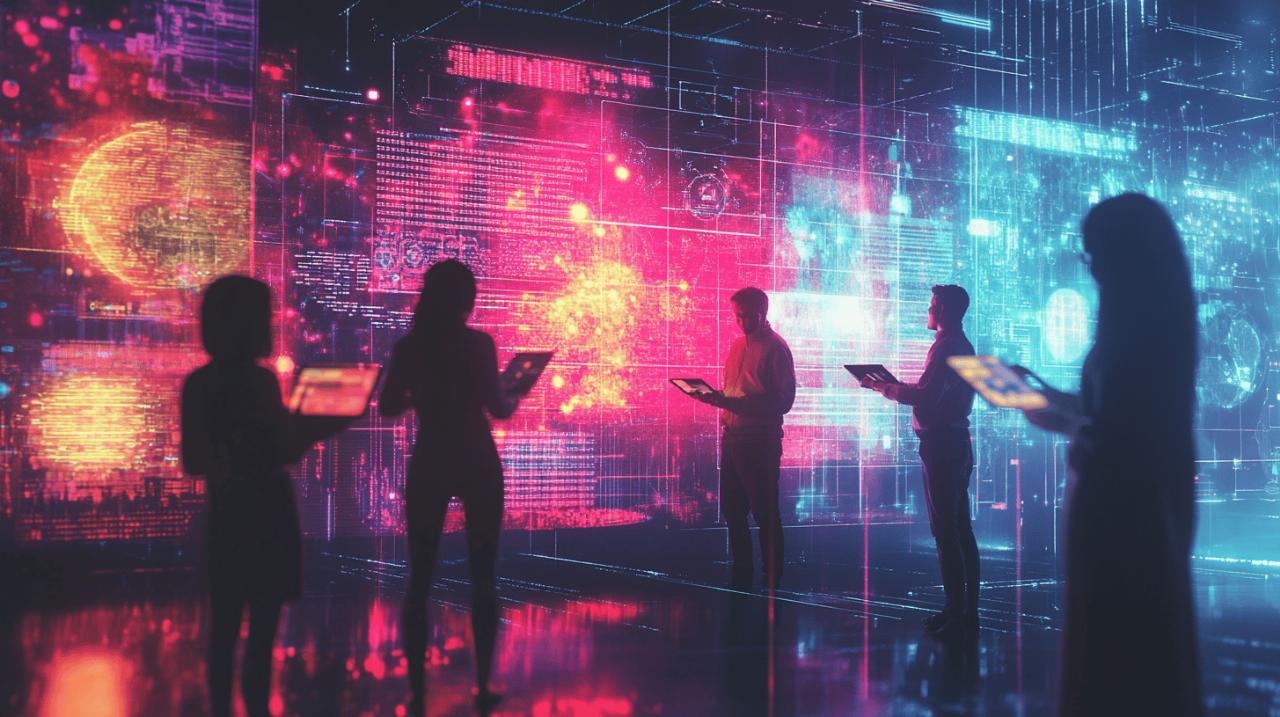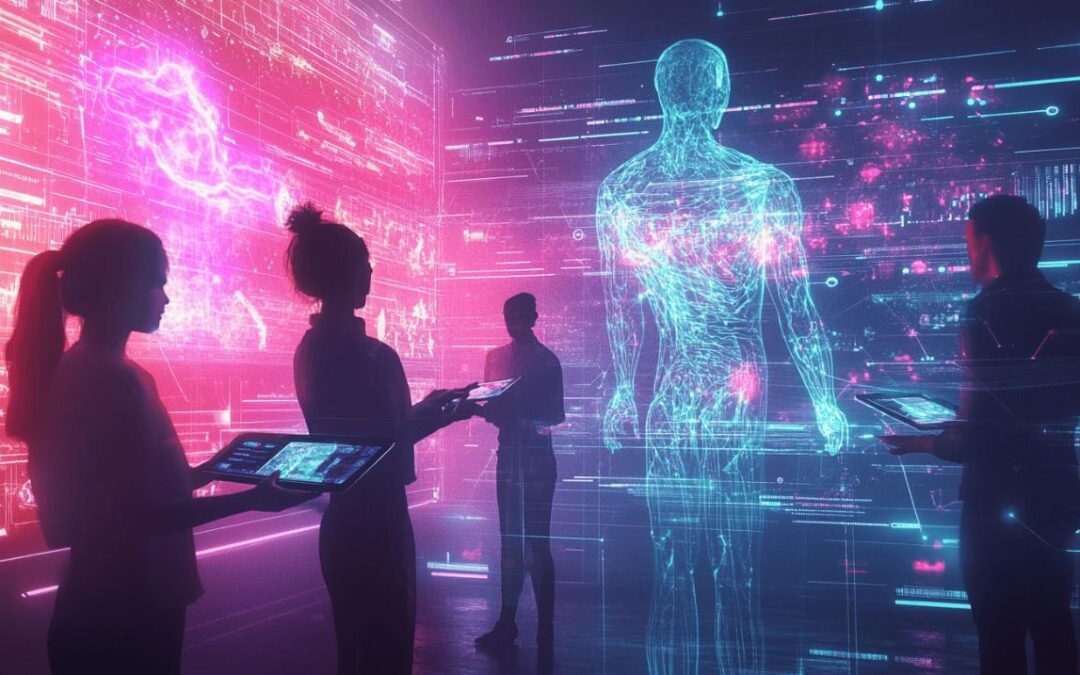The landscape of content creation and design is undergoing a dramatic evolution as smart systems reshape traditional creative processes. Generative AI technologies are now taking center stage in this transformation, empowering creators while introducing new approaches to producing written and visual materials across multiple industries.
Ai-powered content generation tools
Cutting-edge text and image generation platforms are revolutionizing how professionals approach creative work. These systems leverage neural networks and deep learning algorithms to produce original content at unprecedented speeds, enabling both small entrepreneurs and global enterprises to enhance their creative capabilities while maintaining focus on strategic goals.
Text generation capabilities and limitations
Modern language models can draft emails, product descriptions, marketing copy, and blog posts with remarkable fluency. The technology continuously improves through regular updates, making Artificial Intelligence increasingly valuable for content creators seeking efficiency gains. Despite these advances, current systems still face challenges in maintaining consistent quality, avoiding potential biases, and truly replicating the nuanced creativity that humans bring to writing tasks.
Real-world Applications in Marketing and Media
Many organizations now implement generative AI to transform their content strategies. JPMorgan Chase utilizes smart systems to create engaging marketing text, while media companies leverage these tools for personalized content delivery and streamlined production workflows. The integration enables hyper-targeted messaging through data analysis, with studies from Forrester Research indicating that businesses using AI for content creation report up to 68% increases in both productivity and quality. This technology democratizes creative work by making sophisticated tools accessible to a broader range of users.
Visual design revolution through ai
The visual design landscape is undergoing a remarkable transformation driven by artificial intelligence technologies. Generative AI has become a powerful force in creative work, enabling designers to produce stunning visuals with unprecedented efficiency. AI-powered design tools are now capable of analyzing vast amounts of data to generate graphics that resonate with target audiences while maintaining aesthetic quality. This shift represents not just a technological advancement but a fundamental reimagining of the creative process itself.
Design professionals are increasingly incorporating AI into their workflows, with platforms offering specialized solutions for text-to-image generation, style manipulation, and automated layout creation. According to recent statistics, companies leveraging AI for content creation can boost their efficiency by up to 30%, making these technologies increasingly attractive for businesses seeking to optimize their design processes while maintaining high-quality output.
Automated graphic design platforms
AI-powered graphic design platforms are democratizing visual content creation, making professional-quality design accessible to users regardless of their technical expertise. These systems leverage neural networks and deep learning algorithms to generate images, layouts, and visual assets based on simple text prompts or parameters. Platforms like Nation AI offer sophisticated image generation capabilities that help users create stunning visuals while saving time and boosting creativity.
The impact of these automated systems extends beyond mere convenience. Forrester Research found that 68% of businesses using AI for design reported increased productivity and content quality. AI design tools can rapidly generate multiple graphic concepts, allowing designers to explore creative possibilities that might otherwise remain undiscovered. This acceleration of the ideation process enables more experimentation and refinement, ultimately leading to stronger visual outcomes.
The global market for these technologies continues to expand, with the AI market projected to reach $1.81 trillion by 2030. As these platforms evolve, they’re increasingly capable of understanding context, brand guidelines, and aesthetic preferences, producing visuals that align with specific strategic objectives while maintaining creative integrity.
Style transfer and image manipulation technologies
Style transfer and image manipulation represent some of the most fascinating applications of AI in visual design. These technologies allow for the transformation of existing visuals by applying artistic styles, altering compositions, or completely reimagining imagery based on textual descriptions. Tools like DALL-E, MidJourney, and Stable Diffusion have revolutionized this space, enabling designers to translate written concepts directly into visual content.
The practical applications of these technologies are vast. Designers can now instantly apply complex visual treatments that would traditionally require hours of manual work. AI image generators can create customized illustrations, modify stock photography, or generate entirely new visual concepts from text descriptions. This capability has proven particularly valuable for personalization at scale, with AI enabling the creation of tailored visual content for different audience segments.
Beyond basic image generation, sophisticated AI systems can now suggest design modifications based on user engagement data, optimizing visuals for maximum impact. While 54% of people believe AI can enhance visual content, questions remain about AI’s ability to replicate true human creativity. The most effective approaches combine AI’s computational power with human artistic judgment, creating a synergy that leverages the strengths of both artificial intelligence and human ingenuity in the visual design process.
Personalization at scale
Artificial intelligence (AI) has revolutionized content creation and design by enabling unprecedented levels of personalization for users. Through deep learning and neural networks, AI systems can analyze vast amounts of data to deliver uniquely tailored experiences. This technological advancement empowers brands to create personalized content efficiently across large audiences, something that would be impossible through manual methods alone.
Generative AI tools have transformed how creators work, with platforms like Nation AI offering solutions for text generation and image creation that serve diverse users from entrepreneurs to global enterprises. These AI-powered systems save time while simultaneously enhancing creative possibilities. With regular model updates and robust data security measures, these platforms continue to evolve in their capabilities.
Tailoring content to individual user preferences
AI-driven personalization has fundamentally changed how content reaches audiences. By analyzing user behavior patterns, artificial intelligence can craft highly relevant content that resonates with specific individuals. Studies from Forrester Research indicate that 68% of businesses implementing AI for content creation report improved productivity and content quality.
Language models now generate customized text in multiple languages including English, Spanish, Italian, French, German, Portuguese, and Dutch. This multilingual capability expands reach while maintaining personalization. AI writing tools assist with drafting, idea generation, and editing – creating content that aligns with individual preferences while maintaining brand voice.
The impact extends beyond efficiency gains, with Statista revealing that companies using AI for content creation boost efficiency by approximately 30%. These systems excel at analyzing behavioral data to provide hyper-targeted content recommendations similar to Netflix’s personalized viewing suggestions, creating more engaging user experiences.
Dynamic design elements based on user behavior
AI technology transforms design by dynamically adjusting visual elements based on real-time user interaction data. Image generators like DALL-E, MidJourney, and Stable Diffusion convert text descriptions into visual content, revolutionizing how designers create graphics for specific audience segments.
Design tools now leverage neural networks to suggest modifications based on engagement metrics, continuously optimizing visual elements for better performance. This automation streamlines workflows while enhancing image quality, allowing designers to focus on strategic creative decisions rather than repetitive tasks.
The integration of AI with design systems enables brands to present different visual experiences to different users based on their preferences and past behaviors. These dynamic elements adjust automatically, creating personalized journeys that boost engagement. Looking forward, AI will likely continue evolving into a creative collaborator capable of analyzing real-time audience reactions and adapting design elements accordingly.
While questions remain about AI’s ability to replicate genuine human creativity, the most effective approaches combine artificial intelligence capabilities with human ingenuity. This partnership between technology and human creativity promises to deliver increasingly personalized experiences while maintaining authenticity and quality.
Ethical considerations in ai-generated content
The rapid evolution of generative AI has fundamentally transformed creative work across industries. As AI technologies like large language models and image generators become increasingly sophisticated, they present unprecedented ethical challenges that content creators and organizations must navigate. Generative AI offers remarkable benefits—saving time, boosting creativity, and enabling personalization at scale—but also raises complex ethical questions about ownership, attribution, and transparency. With AI models powering everything from writing copy and blog posts to designing visual content, understanding these ethical dimensions becomes crucial for responsible implementation.
Copyright and ownership questions
The rise of AI-generated content has created a murky landscape of intellectual property rights. When AI tools like DALL-E, MidJourney, or Stable Diffusion transform text prompts into visual content, fundamental questions arise about who owns the resulting work. The same applies to text generation through large language models. This uncertainty extends beyond theoretical discussions—businesses leveraging AI for content creation must address practical copyright concerns. Studies from Forrester Research indicate that while 68% of businesses using AI for content creation report increased productivity, many struggle with attribution questions. The legal frameworks governing AI-created works remain underdeveloped, creating potential risks for companies integrating these technologies into their content strategies. Organizations must establish clear policies regarding the ownership of AI-assisted creative outputs, especially when AI generates content based on existing copyrighted materials. Many platforms offering generative AI services are attempting to address these issues through updated terms of service, but the legal landscape continues to evolve rapidly as these technologies become mainstream across creative industries.
Transparency in ai-created works
Maintaining transparency about AI involvement in content creation represents another critical ethical dimension. As AI-generated text and visuals become increasingly indistinguishable from human-created work, disclosure practices gain importance. The statistics show an interesting tension—while 54% of people believe AI can enhance written content, 47% doubt that AI-generated writing can match human quality. This perception gap underscores why transparency matters. Audience trust depends on understanding whether they’re engaging with AI-generated or human-created content. For businesses, transparent practices might include disclosing when content was AI-assisted or fully AI-generated. This transparency extends to media companies, who need responsible AI frameworks with clear accountability mechanisms. The ethical use of generative AI also involves preventing misuse through deepfakes or misinformation—issues that can only be addressed through transparent development and deployment processes. As generative AI democratizes content creation, making it accessible to more users worldwide, establishing ethical norms around disclosure becomes increasingly urgent. The most effective approaches will likely combine AI’s efficiency with human oversight, maintaining creative integrity while leveraging technological advantages.
Future Directions of AI in Creative Industries
Artificial intelligence is profoundly reshaping content creation and design landscapes, offering unprecedented tools that enhance creative processes while maintaining human ingenuity at the core. Generative AI technologies, utilizing sophisticated neural networks and deep learning algorithms, now enable creators to produce high-quality text and visual content with remarkable efficiency. This technological evolution spans across multiple creative domains, with AI becoming an indispensable asset for both individual creators and global enterprises.
The growing adoption of AI in creative fields is backed by compelling statistics – Forrester Research indicates 68% of businesses utilizing AI for content creation report enhanced productivity and content quality. Companies leveraging these technologies can boost efficiency by up to 30% according to Statista. With the global AI market projected to reach $1.81 trillion by 2030, the trajectory of AI-augmented creativity shows no signs of slowing.
Emerging technologies and techniques
The creative landscape is witnessing rapid technological evolution through AI innovations. Text generation has advanced dramatically with sophisticated language models enabling content creation across multiple languages including English, Spanish, Italian, French, German, Portuguese, and Dutch. These systems assist with drafting, idea generation, editing, and content distribution, serving diverse needs from email composition to comprehensive blog posts.
Visual content creation has similarly transformed through AI image generators like DALL-E, MidJourney, and Stable Diffusion that convert text prompts into sophisticated visuals. These technologies employ Generative Adversarial Networks (GANs) to produce autonomous content ranging from basic images to complex design concepts. The integration of AI with virtual reality enhances realism and interactivity in virtual environments, pushing creative boundaries further. AI-powered analytics now transform media insights through real-time data analysis, improving audience segmentation and enabling content personalization at scale. Emerging research explores quantum computing applications, blockchain integration, and ethical AI development frameworks that will define the next generation of creative technologies.
Human-ai collaboration models
The most promising approach to AI in creative industries isn’t replacement but collaboration. AI excels at handling routine tasks while humans focus on conceptual work, forming a symbiotic relationship that maximizes strengths of both. This partnership model allows creators to maintain control over creative direction while benefiting from AI’s efficiency and analytical capabilities.
Practical applications of this collaborative approach include AI suggesting design changes based on user engagement data, streamlining content workflows from ideation to distribution, and scaling personalization efforts. Many organizations have implemented successful human-AI creative partnerships – The New York Times uses AI for photo archive tagging while maintaining editorial oversight, and music companies utilize AI for generation while musicians refine the output. Striking the optimal balance requires thoughtful implementation, with AI functioning as a creative collaborator that suggests ideas and refines narratives rather than replacing human judgment. Organizations investing in both technology and talent development are establishing frameworks that emphasize transparency and accountability, ensuring AI augments rather than replaces human creativity. This approach addresses persistent challenges including content quality control, authenticity preservation, and navigating intellectual property considerations.

